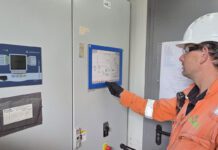
Maintaining the optimum digestion temperature may require additional heating or cooling.
By Matt Hale, International Sales & Marketing Director, HRS Heat Exchangers
This article contains paid-for content created in collaboration with HRS Heat Exchangers.
Maintaining an optimal digester temperature is a key aspect of maximising biogas production and overall process efficiency in anaerobic digestion (AD). Not only is temperature essential to maintain a healthy colony of bacteria, but it can reduce retention times and improve material circulation – thereby helping to increase the production capacity of the whole process.
In terms of temperature regime, AD can be divided into mesophilic or thermophilic systems. Mesophilic digesters are the most common, and operate at between 35°C and 40°C, typically around 37°C. In contrast, thermophilic digesters operate at temperatures above 50°C, with shorter retention times but higher operating energy requirements and are therefore less common.
The methanogenic bacteria in the digester are very sensitive to temperature change, and thermal shocks will reduce the level of methane production. Therefore, it is essential to monitor digester temperature and retain the correct temperature window using heating in order to prevent reduced digester performance. Heating is also required to compensate for heat losses from the digester to the atmosphere and to compensate for the thermal loads which occur when new feedstock is added to the digester.
In some cases, cooling may also be required, for example where the feedstock coming into the digester comes from a higher temperature pre-treatment system such as a pasteuriser or hydrolysis tank. Cooling can also be required in regions with very high ambient temperatures.
Indirect heating (or cooling) based on heat exchangers involves taking sludge from the digester, pumping it through a heat exchanger, and then returning it to the digester at the required temperature. The heat exchanger control system considers variable heat loads from different feedstocks and seasonal changes in ambient temperature.
Such an indirect system also has advantages in terms of servicing over older style heating systems which may have a system of pipes in the floor or lower walls of the digestion tank. These systems are being phased out as the pipework is in an aggressive environment so often has a shorter lifespan. It also has the disadvantage that if embedded pipes spring a leak, the digester has to be drained in order to access the pipework, leading to considerable delays and costs.
It is when you consider potential sources of heat that things become most interesting. Obviously generating heat specifically for the purposes of heating the digester is expensive, inefficient, and in some cases will lead to carbon emissions. But in most an AD plants there are sources of existing heat which can be utilised, in particular heat from the combined heat and power (CHP) engine, which may otherwise be wasted. Using a heat exchanger, such as the HRS DTI Series, means that this source of heat can be utilised effectively thanks to their corrugated tube design which reduces fouling and blocking, resulting in long running time with high levels of heat transfer.
Conversely, where cooling is required, it can easily be supplied via a heat exchanger using a medium such as water, and where AD plants are located in regions with wide variations between winter and summer temperature, it may be that both heating and cooling is required. While such a situation will inevitably add complexity to the system design, it is also perfectly feasible to meet such a brief.
So, to return to the question posed in the title: the answer is that it all depends on the actual temperatures you are faced with and the optimum operating temperature of your particular digester. The good news is that whether you need to heat or cool, corrugated tube heat exchangers represent the most energy efficient way to achieve this.






